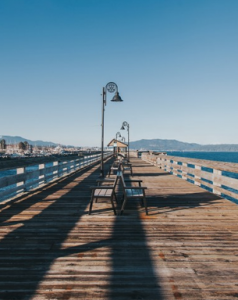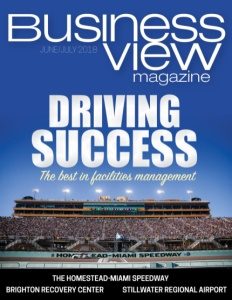Campbell River, British Columbia
An economic renaissance
Business View Magazine interviews Andy Adams, Mayor of Campbell River, BC, as part of our focus on best practices of Canadian cities.
Campbell River, a city of about 32,000 people, halfway up the eastern coast of Vancouver Island, was named after Dr. Samuel Campbell, ship’s surgeon on the HMS Plumber, an 8-gun, wooden screw sloop of the Royal Navy that plied Discovery Passage, the narrow channel that separates Vancouver Island from Quadra Island, and further east, the rugged Coast Mountain range of mainland British Columbia, around 1859.
 Campbell River is known as the “Salmon Capital of the World,” because the Campbell River, itself, which the city is named for, is a salmon-bearing stream for all five species of fish: the Chinook, the Coho, the Sockeye, the Pink, and the Chum. Of these, Chinooks that weigh 30 or more pounds, and known by the Indian name, Tyee, which means “The Chief,” are the most prized. Indeed, sports fisherman had travelled to the area as early as the 1880s, and especially after the late 19th century publication of Sir Richard Musgrave’s tales of the excellent fishing he had off the mouth of the Campbell River, over several seasons.
Campbell River is known as the “Salmon Capital of the World,” because the Campbell River, itself, which the city is named for, is a salmon-bearing stream for all five species of fish: the Chinook, the Coho, the Sockeye, the Pink, and the Chum. Of these, Chinooks that weigh 30 or more pounds, and known by the Indian name, Tyee, which means “The Chief,” are the most prized. Indeed, sports fisherman had travelled to the area as early as the 1880s, and especially after the late 19th century publication of Sir Richard Musgrave’s tales of the excellent fishing he had off the mouth of the Campbell River, over several seasons.
The Tyee Club, which was formed in 1924 over concerns regarding over-fishing of salmon stocks, further popularized the area among fisherman. To this day, any angler capable of catching an elusive, 30-plus pound Tyee, while in a non-motorized rowboat, using no downriggers or weights, just a spoon or a plug, and can reel it in by hand, becomes a member of the Tyee Club.
Commercial fishing was a large industry in Campbell River for many years, and industrial logging took off in the 1920s. In addition, the area was home to several zinc, coal, and copper mines. After World War II, Campbell River became a boom town and industrial center with the building of the John Hart Dam. “The town was very fortunate in 1947, to have BC Hydro build an electric power generating station that provided all the power for the middle and north island,” says Mayor Andy Adams, a city councilor since 2005, and mayor since 2014. “It was also the driving force behind the Catalyst Pulp and Paper Mill, and then the Timber West Sawmill, being based here and powered off of that generating station.”
“But times have changed,” Adams continues. “When I first got on Council, 13 years ago, the resource industries were beginning to take a significant hit. By 2010, in a matter of 18-24 months, we had the sawmill close permanently; we had the pulp and paper mill close permanently; we had two mines in our regional district area shut down. That was a hit in excess of 3,500 well-paid jobs for a community, which at that time was less than 30,000 people.”
And yet, Adams reports that the city survived that combination of knock-out blows. “Catalyst had five pulp mills on the west coast in different communities, and we were the only community, where Catalyst had shut down, that has not decreased in population. And that’s a testament to people here, who, for many years, went off and commuted to the oil patch in Fort McMurray, or worked in diamond mines in the Northwest Territories; I had friends who commuted to Barrick Gold in the Dominican Republic and to some of the mining operations in Peru. They’d leave their families and go away for three weeks out and two weeks in, or sometimes months at a time. But, they kept their families here; they kept their houses here; they kept their kids in school, here.”
Even so, the loss of those companies was a $6 million dollar hit to Campbell River’s tax base, “which meant we had to re-invent how we were doing things and how we were going to keep the lights on and keep the infrastructure maintained, and also, develop for future growth,” Adams notes. “So, we were very fortunate that BC Hydro, with that original hydro dam, made the decision to reinvest and replace that generating station. For the past five years, we have had a $1 billion capital project from BC Hydro to build a brand new, state-of-the-art generating station, underground. We are just shutting down the old generator, now, and will be starting up the new one, which provides power for 30 percent of Vancouver Island.”
Because of the new power station’s underground design, the City was forced to replace its dedicated water supply and water treatment facilities. “The old generating station had penstocks above ground, providing the water out of the reservoir,” Adams explains, “and the city was drawing its water supply off of those penstocks, which meant that, in addition to that billion-dollar project for Hydro, the city had to invest in its infrastructure. And that project is due to complete this spring. It’s the largest capital project for the City of Campbell River in its history at about $39 million. And that is coming in on time and on budget.”
Another recent project that has boosted Campbell River’s economy was the decision made by the provincial government to rebuild the Campbell River Hospital. “Four months ago, we cut the ribbon and opened the doors to a state-of-the-art, brand new, acute care hospital,” says Adams. “That was a $300 million infrastructure project that really helped tide us over as we were transitioning our economic base.”
While Adams says that Campbell River benefitted from these major capital projects, he stresses that the city was concurrently putting programs in place to attract investment and spark a revitalization of its downtown. “Seven years ago, we created a downtown tax exemption, which was for developers in a finite area in the downtown core, to encourage them to redevelop,” he reports. “We have had an uptake of seven large facilities. Broadstreet Properties, for example, the largest apartment builder in western Canada, have all of their office team, here. They took up an entire block that was previously assessed at about $1.1 million; they bought it, built a $17 million head office building, and they do not pay tax for a five-year period on the difference between the purchase price and the assessed price. We also had Berwick Homes set up here. It’s a beautiful facility for active seniors and a significant $20 million investment in our downtown core.
“There’s a brand new Comfort Inn and a new apartment building to get some residential living in the downtown core. All of those investments, with that downtown tax incentive meant that, while we weren’t getting revenue right away, we were providing an incentive – and, knowing that revenue would be deferred for a five-year period, we could then plan for that new revenue coming in to help with further investments in the downtown infrastructure.
“Tied in with that, we did a couple of other programs for downtown revitalization through a façade improvement program. That’s been running for five years. The City puts out a call to the private businesses in the downtown to say, ‘We’ll put up 50 percent of the money if you want to redo the look on the outside of your building.’ That’s tied in with a sign program so that we can get away from the neon backlit signs and into more decorative signs that provide a more intimate and attractive atmosphere in the downtown core. That’s been received extremely well and it’s meant for some beautification in our area.
“That’s combined with the City’s initiative of live streets; we are closing down Campbell River’s main street for events on weekday evenings in the summertime – whether it be for concerts or markets. We’re also putting in ‘parklets” all over the place for more people-gathering places. Those are some of the places where we put money aside to match with individual businesses for improvements, and it’s a win-win situation.”
 In addition, Campbell River recently promoted a marketing initiative called the CR Advantage, after installing Vancouver Island’s first municipally-owned, broadband fiber network. Adams explains: “In British Columbia, in order to get enterprise-level, broadband fiber, you needed to be in Vancouver, Victoria, or Kelowna – larger centers where Telus and Shaw provided an affordable rate structure for that enterprise level because they had the economies of scale with the number of customers that they had. What we decided to do here was make the investment, ourselves, and create a downtown loop that’s city-installed and city-owned. It’s a one-gig, simultaneous up and download speed, broadband fiber. It’s been in the works for a couple of years and we have just opened it up and contracted the first independent service provider to deliver the fiber. And we are working in partnership with Shaw Communications as we connect with the main line coming from the lower mainland.”
In addition, Campbell River recently promoted a marketing initiative called the CR Advantage, after installing Vancouver Island’s first municipally-owned, broadband fiber network. Adams explains: “In British Columbia, in order to get enterprise-level, broadband fiber, you needed to be in Vancouver, Victoria, or Kelowna – larger centers where Telus and Shaw provided an affordable rate structure for that enterprise level because they had the economies of scale with the number of customers that they had. What we decided to do here was make the investment, ourselves, and create a downtown loop that’s city-installed and city-owned. It’s a one-gig, simultaneous up and download speed, broadband fiber. It’s been in the works for a couple of years and we have just opened it up and contracted the first independent service provider to deliver the fiber. And we are working in partnership with Shaw Communications as we connect with the main line coming from the lower mainland.”
CR Advantage is a tool that the city employs to attract area firms, as well as high tech companies and incubators from neighboring cities such as Victoria, Vancouver, and Seattle. “You can have the fiber supply that you require to be able to do business in an office space that is a sixth of what you currently pay, and a quality of life and cost of living where your employees will be able to put a few more bucks in their pockets,” Adams exclaims. “And we’re getting some real good interest. In four months, we have five local businesses that have signed on; we have a sixth one that will be signed up next month. So, we’re expanding into tech, and expanding into more commercial retail, but still keeping close to the things that are the largest employers that we have here, which are the forest and aquaculture sectors, closely followed by tourism.”
Adams adds some more good news about Campbell River’s economic renaissance. “Both mines that closed ten years ago, are now reopening,” he states. “The quality and the grade of coal that we have here is such that there is a world market for it. They are beginning extraction now and starting to call people back to work. In its heyday, it was about 160 employees; they currently have called back about 60 and the target is 180 within a year. The Nyrstar Mine is a little further along; they have a target of 380 employees to call back within the next 18 to 24 months.” (Nyrstar Corporation owns the Myra Falls mine, which has a geologically diverse collection of minerals: zinc, copper, gold, lead, and silver.)
As the local economy has heated up, Adams says that the city has kept pace in terms of its internal operations. It is the first municipality in BC to complete its yearly financial plan before each subsequent fiscal year begins, which helps move the design, budgeting, and construction of projects, faster and farther along; and it has moved from promulgating a five-year capital plan to a ten-year one, which helps it to better calculate borrowing costs and time frames. “Going to a ten-year plan means that we’re preparing ourselves for projects that we know need replacement, and we know need assistance from other levels of government. It means that we are design-ready, shovel-ready, and money-ready.”
Some infrastructure projects on the agenda include increasing and upsizing the city’s sewer pipes along its waterfront to assist in the growth of residential and commercial communities, rebuilding the waterfront highway, and enhancing the sea walk with safe bike paths, center medians, underground lighting, and treescaping. “We also have a sustainability plan embedded in our strategic plan,” Adams adds. “We were the first City Hall in BC to have a green roof, and we’ve got a bunch of other initiatives that we’re doing. We have a proposal in for a regional organics facility that would divert organic and kitchen waste away from the landfill. That is something that we have been successful in getting a federal grant for, and we’re working through the details on how that’s going to happen.”
Campbell River, British Columbia – so much more than just the “Salmon Capital of the World.”
Check out this handpicked feature on The Kaskaskia Regional Port District – Moving up and shipping out.
AT A GLANCE
WHO: Campbell River, British Columbia
WHAT: A city of about 32,000 people
WHERE: Halfway up the eastern coast of Vancouver Island
WEBSITE: www.campbellriver.ca
PREFERRED VENDORS

Cermaq Canada – www.cermaq.com
Cermaq Canada is a salmon farming company based in Campbell River, British Columbia, Canada, producing more than 21,000 tonnes of fresh, healthy salmon each year. The company is part of Cermaq, the world’s second-largest salmon farmer and an important part of the Campbell River economy. Cermaq Canada creates more than 250 jobs in coastal communities, and is an important customer for the supply and support industry in Campbell River and Vancouver Island.

Nyrstar www.nyrstar.com–
Nyrstar’s management has a strategy aimed at positioning the business for a sustainable future as a leading metals processing business. Through its deep market insight and unique processing capabilities, Nyrstar aims to generate superior returns by extracting the maximum value inherent in the mineral resources and by-products it processes. Accordingly, Nyrstar has developed a coordinated approach to redeveloping and operating its asset portfolio to optimize the concentrate feed into its smelters, maximize minor and precious metal extraction, and enhance the margins of its end-product mix.






